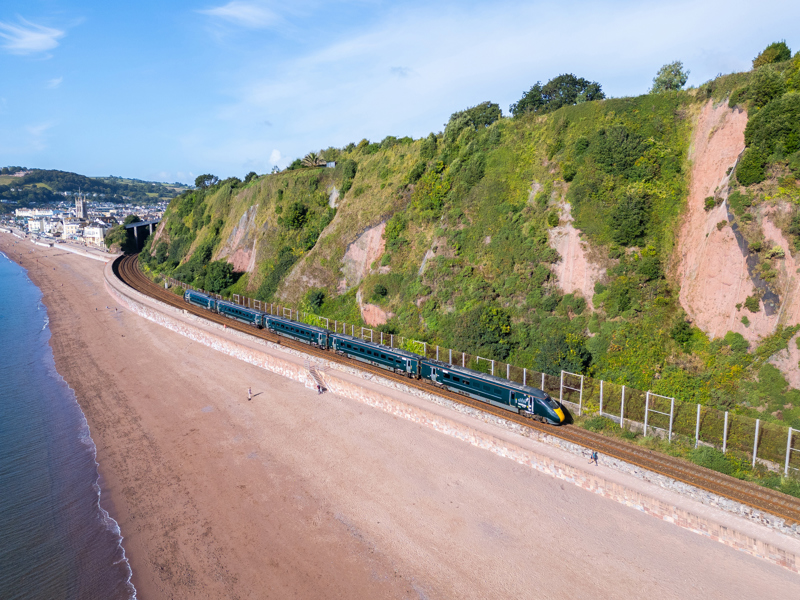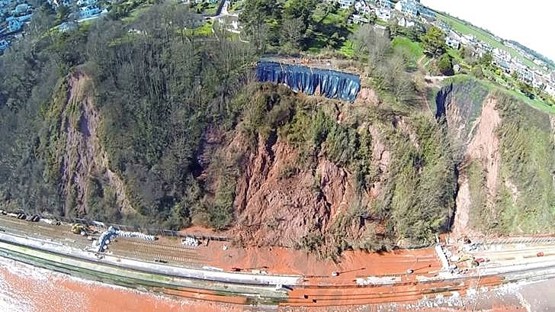
The fifth phase of works to protect the railway between Dawlish and Teignmouth remains unfunded, almost a year after Network Rail filed its submission.

The fifth phase of works to protect the railway between Dawlish and Teignmouth remains unfunded, almost a year after Network Rail filed its submission.
NR estimates that the cost of the final part of the South West Rail Resilience Programme (SWRRP) could reach between £335 million and £466m - the first time a figure has been put on the work.
Some £165m has been spent on the first four phases of the programme, which was established in response to the eight-week closure of the railway in 2014.
That has included rebuilding the sea wall at Dawlish, constructing a new rockfall shelter at Parsons Tunnel, and fixing nails and netting to the cliffs above.
Phase 5 aims to prevent landslips that could cause prolonged closures along a one-mile stretch between Teignmouth and Parsons Tunnel. Varying amounts of cliff containment and improved drainage are envisaged in 15 separate “behavioural units”, with engineers dividing the area into various zones rated between low and high risk.
Work would include installing soft nails and netting to help catch surface slippages caused by spray and sea water, as well as deep cliff wells to help pump out water - in a bid to prevent larger subsidences, such as the rockfall which occurred at the same time as the washout at Dawlish in 2014.
NR told RAIL the projected cost was a “high-level estimate” predicated on aiming to meet the requirements for a similar resilience level (100 years) as Phases 1-4.
Tom Smith, the designated project engineer for SWRRP, explained that if funding was approved, deep wells would first be drilled in up to three locations.
“The deepest would be 65 to 75 metres, depending on the location," he said.
“It’s very difficult to pinpoint where you need to intervene,” he added, explaining that layers of rock change within the cliffs, such as bands of sand and then aggregate.
“This is why the trials are so important. You need to get to the full depth of the cliffs - it's proof of concept."
Water would then be pumped into nearby surface water streams.

The trial wells would be prepared in time for the “wettest time of the year”, which Smith said would be March. These would be monitored for two to three months, before the results are analysed over the following months to assess whether the design is suitable for a full rollout along that stretch of line.
However, this work is dependent on funding, with Smith noting: “At the present time, it isn’t there. At the moment, no work is progressing on the final solution.
The Conservative government’s Network North document of October 2023 pledged to set aside funding to complete the work "in full".
NR submitted its request for Phase 5 funding to the Department for Transport in spring 2024, but it remains part of the Labour administration's Spending Review.
In a letter to Truro and Falmouth MP Jayne Kirkham (Labour), written in December 2024, Rail Minister Lord Hendy said: "This work is expected to cost substantially more than the other four phases combined and is currently not funded. However, it will be considered as part of the multi-year Spending Review.
"The Secretary of State is conducting a thorough review of the previous government's transport plans to ensure that our transport infrastructure portfolio drives economic growth and delivers value for money for taxpayers. Decisions about individual projects, including the final phase of the SWRRP, will be informed by the review process and confirmed in due course.”
During a Westminster Hall debate on January 14, Newton Abbot MP Martin Wrigley (Liberal Democrat) said he had been told by Network Rail that the design team would be reassigned if funding was “not seen to be forthcoming soon”, something he feared would delay the project and increase costs.
Responding to Wrigley, Transport Minister Simon Lightwood told MPs that the government continued to work with Network Rail as it developed Phase 5 proposals.
The existing project team has work and funding until early summer 2025. The design team has not been contracted as that would be subject to funding.
Smith warned that if Phase 5 “went into the long grass, we would have to redo” the monitoring work completed to date.
A spokeswoman added: “This would not offer the same resilience as the entire scheme, but would increase resilience locally against smaller, more frequent surface failures. The programme is also producing a monitoring strategy that Network Rail asset management could use to monitor the assets in the interim.”
A Great Western Railway spokesman said SWRRP had done “a huge amount to improve this vital part of the rail network, and we are already seeing the benefit of that work”.
He added: “We will continue to work with Network Rail and government on further investment in vital projects to improve the railway’s reliability and resilience.”
NR said it was surveying existing infrastructure to “identify efficient ways of enhancing or renewing these assets in the short term”.
Login to continue reading
Or register with RAIL to keep up-to-date with the latest news, insight and opinion.


















Login to comment
Comments
No comments have been made yet.